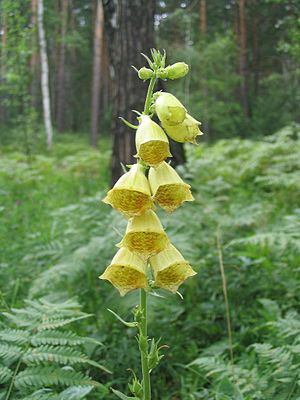Large-flowered foxglove
| Large-flowered foxglove | ||||||||||||
|---|---|---|---|---|---|---|---|---|---|---|---|---|

Large-flowered foxglove ( Digitalis grandiflora ) |
||||||||||||
| Systematics | ||||||||||||
|
||||||||||||
| Scientific name | ||||||||||||
| Digitalis grandiflora | ||||||||||||
| Mill. |
The large-flowered foxglove ( Digitalis grandiflora Mill. , Syn . : Digitalis ambigua Murray ) is a species of the plantain family (Plantaginaceae). It is also known as the large-flowered yellow foxglove .
description
The large-flowered foxglove is a perennial, herbaceous plant and can reach a height of 70 to 120 cm during the flowering period. The flower-bearing shoot begins to develop from a basal rosette of leaves in May. In June and July the plant bears twenty or more yellow flowers in one-sided racemose inflorescence . The flowers are hairy glandular, they are 3 to 4 cm long and have a brown, reticulated pattern on the inside. Two-sided, many-seeded capsule fruits are formed.
The species chromosome number is 2n = 56.
ecology
The large-flowered foxglove is a hemicryptophyte and is one of the most striking forest plants in Central Europe. The pre-male flowers are pollinated by Hymenoptera ( bumblebees , bees ); also self-pollination is possible.
Site conditions
The large-flowered foxglove can be found scattered, but sociable in grassy perennial corridors, in forest clearings, woodlands, on the edges of forests, in sunny stone slopes. It loves clay soil that is moderately rich in alkaline, litter and nitrogen. According to ELLENBERG , it is a sub-oceanic half-light plant, a freshness and moderately acid indicator . It grows on moderately nitrogen-rich sites and is a federation character of the fireweed forest clearing corridors ( Epilobion angustifolii ). On the playing surfaces it is a character species of the Calamagrostio-Digitalietum grandiflorae from the Atropion association, on the subalpine tree line it is a local character species of the Sorbo Calamagrostietum from the association of high grass meadows (Calamagrostion arundinaceae), but also occurs in light Fagetalia societies or in the Geranion association sanguinei before.
In the Allgäu Alps, it rises in the Tyrolean part on the Jöchelspitze up to 1820 m above sea level.
This plant species is completely protected.
Toxicity
The plant is poisonous in all parts due to cardenolides ( digitalis glycosides ). The leaves contain 0.2% glycosides of the digitoxin type and about 0.1% those of the digoxin type. Nevertheless, the plant does not play a role in the production of cardiac glycosides.
Common names
For the large-flowered foxglove, the other German-language trivial names exist or existed : Bocksbart, gel Fingerhütlin ( Silesia ), Fuchskraut, gel Glöcklin, Neunkraut (mentioned as early as 1482), Waldschell and Wundkraut.
photos
literature
- Manfred A. Fischer , Wolfgang Adler, Karl Oswald: Excursion flora for Austria, Liechtenstein and South Tyrol. 2nd, improved and enlarged edition. State of Upper Austria, Biology Center of the Upper Austrian State Museums, Linz 2005, ISBN 3-85474-140-5 .
Individual evidence
- ↑ a b Erich Oberdorfer : Plant-sociological excursion flora for Germany and neighboring areas . 8th edition. Stuttgart, Verlag Eugen Ulmer, 2001. Page 846. ISBN 3-8001-3131-5
- ↑ Erhard Dörr, Wolfgang Lippert : Flora of the Allgäu and its surroundings. Volume 2, IHW, Eching 2004, ISBN 3-930167-61-1 .
- ^ Georg August Pritzel , Carl Jessen : The German folk names of plants. New contribution to the German linguistic treasure. Philipp Cohen, Hannover 1882, page 135. ( online ).
Web links
- Digitalis grandiflora Mill., Large-flowered foxglove. In: FloraWeb.de.
- Large-flowered foxglove . In: BiolFlor, the database of biological-ecological characteristics of the flora of Germany.
- Profile and distribution map for Bavaria . In: Botanical Information Hub of Bavaria .
- Digitalis grandiflora Mill. In: Info Flora , the national data and information center for Swiss flora . Retrieved March 12, 2016.
- Thomas Meyer: Thimble data sheet with identification key and photos at Flora-de: Flora von Deutschland (old name of the website: Flowers in Swabia )
- Ingredients of the large-flowered foxglove


